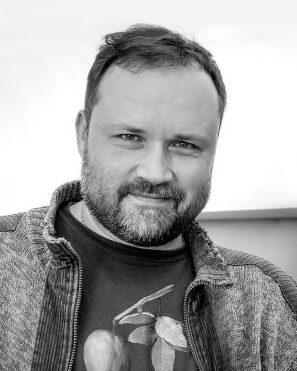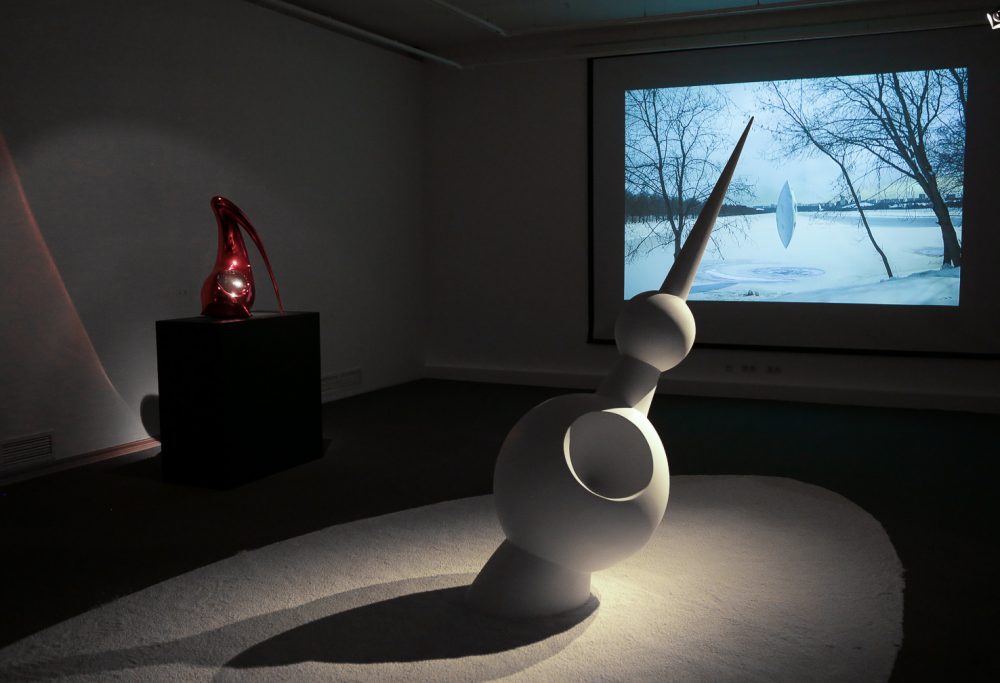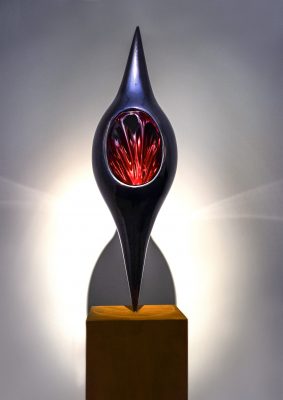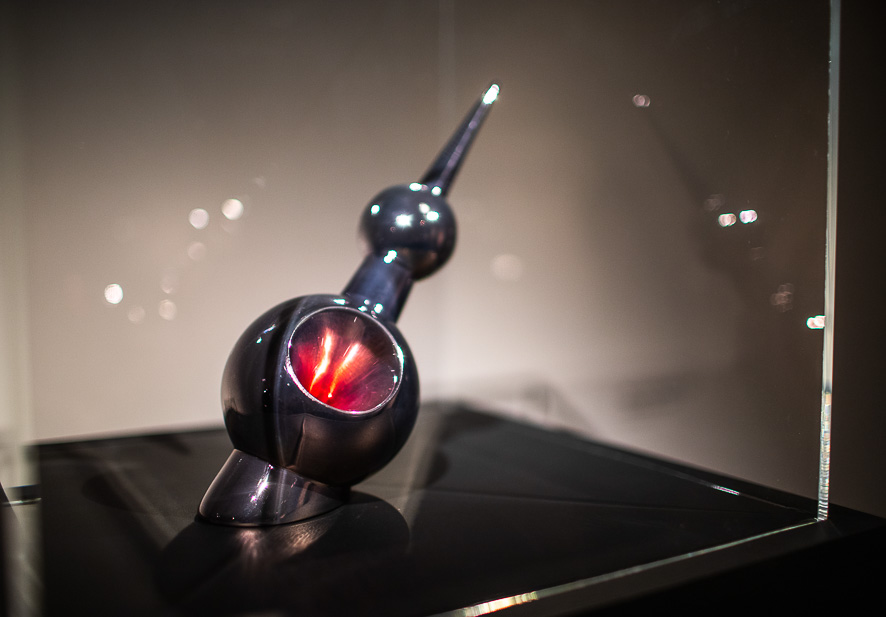On January 22 the Cultural Foundation “EKATERINA” presented the solo show “Being and Time” by Valentin Korzhov. Natalia Bezrukova spoke to the artist about his creative path, the Asian art market and inspiration.

Valentin Korzhov Photo by Dmitry Kilpio
Natalia Bezrukova: Valentin, you are a graduate of a pedagogical university, an art and graphics faculty. Why did you decide to become an artist, and at what moment did you understand that it is your path?
Valentin Korzhov: I didn’t have the decision to become an artist. I cann’t even imagine the situation in which we can make such a decision. In the early period, I had a passion of watercolor painting. At a certain moment, this enthusiasm developed into the desire to enter an art university. And then I met a very talented teacher on my way, sculptor and metal artist Sidorenko, and he invited me to work as an assistant in his workshop. And gradually, my intentional desire began to turn into a matter of my life.
NB: You work in different genres – sculpture, video, photography, installation. Which is the closest to you and why?
VK: The closest thing to me is sculpture, an object, a form. I tried all the major media – from traditional to modern, digital projects that require not only digital technologies, but also programming. But after all I returned to the sculpture. Alexander Moiseevich Pyatigorsky said: “We don’t make the choice, our heart’s chakra is simply an evidence of it”. (Alexander Moiseevich Pyatigorsk – a Soviet and British philosopher, orientalist, Indologist, Buddhologist, writer, candidate of philological sciences. – ed.).
NB: I noticed that someone on Facebook under the picture of the production of your works causticly commented: “Jeff Koons for the poor.” Do you associate some of your sculptures with the sculptures of Koons?
(Jeff Koons – born in 1955, an American artist, famous for his kitsch stainless steel sculptures which are covered with a color glossy finish. One of the most expensive artists of our time. – Note from the author).
VK: Rather not, but the neon colors and the glare of the polished metal make some reference to his works. If we are talking about the topology of my path, probably, three figures continue to influence on me – they are Henry Moore, Francisco Infante and Anish Kapoor. They are the artists who made and stil make a significant impression on me.

Fragment of the exposition Being and Time in the Cultural Foundation EKATERINA Photo by Natalia Dumko
NB: Before the exhibition at the Cultural Foundation “EKATERINA”, a part of “Being and Time” was shown at the main project of the VIII Tashkent International Biennale of Contemporary Art in 2018. After the exhibition at the Fund, some of the works will go to the Bahrain Across Borders fair in Bahrain. Why Asia, not Europe?
VK: Well, first, it is my love for everything that is called “oriental” and, of course, for medieval oriental aristotelianism, which is a part of the context of my works.
Western audience is more rational, it is different when it concerns promoting. When purchasing art, they are concerned about the further cost of works, the demand for the name of the artist, the conclusions of art critics and the main thing – that the object is a part of a particular context. And the Asian market is more open as it is dynamic and young, and therefore it is ready for novelty, it is a place for both rating deals and impulse shopping.

Exposition “Being and Time” in the Cultural Foundation EKATERINA Photo by Dmitry Kilpio
NB: And in the east, how do they perceive the idea which you invest in your projects? Heidegger, the being, the time … How is it read in the oriental world, in the world of a different culture?
VK: Even with the seemingly complete globalization, the true Islamic world is tight enough, as can be seen from the politics. For example, I need to go to the fair in Bahrain in two weeks, and I have already been sent a document about the behavior at the exhibition, which says that women should be dressed in a certain way – with covered shoulders and knees, none of the events must serve alcohol. I’ve recently met an Arabist, director of the Institute of Philosophy of the Russian Academy of Sciences and Academician Smirnov. And just during the preparation of my texts for the exhibition “Being and Time” we had a conversation on the theme of the cultures of Europe and Asia. So he said that the form “to be” is absent in Arabic. That is, such a concept as “is” is completely absent. The Europeans and we either have everything or not. At the same time, despite the fact that the mass culture makes the whole space global, at its core both the east and the west have very different hermetic cultures. But if we are talking about anthropology, I am still a supporter of the idea that there is no difference between people of the east and the west. There is a good representative of the Eastern world, and there is a scoundrel. There is a good representative from the Western world, there are scoundrels.
Three figures continue to influence on me – they are Henry Moore, Francisco Infante and Anish Kapoor. They are the artists who have already made and still make a significant impression on me.
Speaking about the perception of my works, the point is probably not in the writings of Heidegger or Ibn Al Arabi, but in an attempt to comprehend the cosmos as a source of intellectual revelations or what the Greeks called an intelligent body. Circling the contours of the constellations, I fix a certain given, which manifests itself in a form. Such an act of creation does not imply the limits of perception and does not imply the division into the Western and the Eastern.

The exhibition “Being and Time in the Cultural” at the Foundation EKATERINA Photo by Dmitry Kilpio
NB: Is it possible to say that your gallery owner Alexander Sharov is involved in your presence at the oriental art scene? The first Russian gallery in Asia is the branch of Gallery 11.12 in Singapore, which was opened in 2012. It seems that there is a connection between these events.
VK: I have great a respect for his international expansion and success. Alexander for me is a mentor and inspirer, and his recommendations are at the basis of my promotion strategies. In fact, we have not yet implemented a joint project, but we are conducting a dialogue about such an opportunity.
NB: How can you characterize your potential buyer?
VK: My objects can be integrated into large interior spaces. Well, not for nothing that they call me Koons for the poor (laughs). Therefore, there is a circle of architects who work with my stuff.
NB: Judging by the appearance of the sculptures, their production is very expensive. Tell the secret where the funds for production come from?
VK: Partially I try to invest the funds from the sale of my works, of course, that is not enough, and I have to conduct parallel business activities.
NB: Isn’t it related to the art?
VK: Not. It is very important to me, because it makes me independent from the market. I can make the things which I want to make without considering the sales and, to be honest, without considering the institutions who decide to exhibit my art or not.
NB: In your projects, in my opinion, the following chain of topics can be traced: the memory – the time – the man – the religion – the space. The alignment of the “great” topics in that order takes place intentionally or accidentally?
VK: You’ve noticed the thing to which I have not given such a meaning, and it is gratifying. Kirill Alekseev, the curator of the exhibition at the Foundation, just believes that the artist captures the moments of our reality, and he is not responsible for that how it will affect the viewer. Because the author has a different role – the role of the fixer, and then the beauty is in the eye of the beholder. And it’s always very hard for me to listen to stories about what an artist wanted to say, or not wanted to say.
NB: About curators. Your show in the 11.12 gallery “Flesh and Heaven” was supervised by the foreign independent curator Attilia Fattori Franchini. How did you like that experience?
VK: Attila won my trust at the first meeting when she told me that there wasn’t supposed to be a well thought-out and logical sequence. We needed to mix all the components of the project, because as soon as we try to build everything in the hierarchy, we can deprive the life of the project and its “authenticity” which exists right at the moment of creating. And the works of three projects were collected at the exhibition, though previously I had thought it was impossible. And I think that none of the Russian curators could agree with Attilia in her views on the exposition.

The exhibition “Being and Time” in the Cultural Foundation EKATERINA Photo by Anna Ponomareva
NB: You know, I am very impressed by the phrase of Pablo Picasso about inspiration: “Inspiration exists, but it has to find you working. Do not waste a lot of time waiting for the “right” moment. If inspiration comes – fine, create! But do not limit yourself to the duration of this magical component. ” And how about your inspiration?
VK: I am lucky – I do not have any idea what inspiration is. I have an inquisitive desire to understand something, in the case of sculpture I try to understand it in its form. And the moment when I realized the joy of this understanding can probably be called inspiration.
NB: Your new exhibition at the Cultural Foundation “EKATERINA” has the same name as one of the most important works of the German philosopher Martin Heidegger, in which he discusses the concept of being. Without going deep into Heidegger, what do you personally put into the concept of “being”?
VK: I dont know. And in this ignorance there is precisely the path of my works, the thirst for creativity. Because I’m trying to grab it in art. The philosopher tries to grasp it in a text, the poet in a rhyme, the musician in seven notes, and I try to grab it, catch in a shape.
Natalia Bezrukova is a museologist, art historian, currently working as a coordinator of exhibition projects at the Ekaterina Cultural Foundation.
Valentin Korzhov lives and works in Moscow. Member of the sculpture section of the Moscow Union of Artists. Participant of many group exhibitions. His personal exhibitions were held at 11.12 Gallery in the Center for Contemporary Art Winzavod (Flesh and Sky, 2018), the State Darwin Museum (Lessons of Natural History, 2017), the Voronezh Academy of Arts (White Kurgan, 2014), Gogol Center ( “The Archeology of Memory”, in the framework of the Parallel Program of the 5th Moscow Biennale of Contemporary Art, 2013).
“Being and Time” by Valentin Korzhov is open in the Cultural Foundation “EKATERINA” until March 24, 2019.